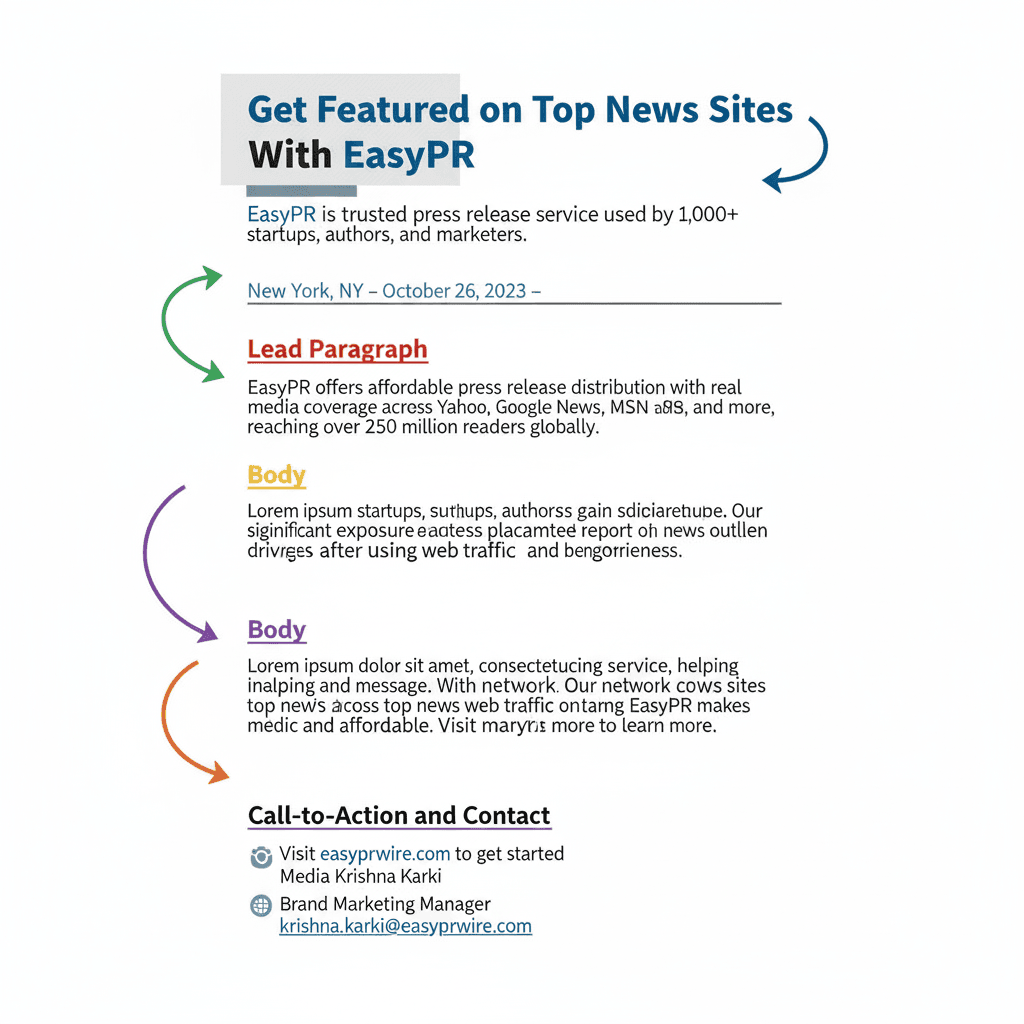A press release is one of the oldest tools in public relations, yet it remains just as relevant in 2025 as it was decades ago. At its core, a press release is a structured piece of writing designed to share newsworthy information with the media, stakeholders, and the public.
But what separates an effective press release from one that gets ignored?
The answer lies in its anatomy: the structure, flow, and components that give it power. Much like a building relies on its foundation, a press release relies on its parts: headline, body, boilerplate, and more.
In this guide, we’ll break down the essential parts of a press release, explain why they matter, and share real-world examples and templates you can use right away.
What Is the Purpose of a Press Release?
The purpose of a press release is to deliver news in a concise, credible, and engaging way. It’s not just about announcing something, it is about creating a story the media can quickly pick up and share.
So, how does a press release work today? In an age of digital-first journalism, editors and reporters scan dozens of press releases daily. The ones that are clear, timely, and structured correctly have the best chance of making it into a news story. Beyond media pickup, a well-written release also boosts search engine visibility, adds authority to a brand, and provides content that can be repurposed across websites and social media.
A common question arises: is a press release the same as a news release? In practice, yes. The terms are often used interchangeably. Another frequent point of confusion is whether a press release is an article.
The answer is no: a press release is factual, straightforward, and follows a set structure, unlike opinion-driven articles.
For businesses, nonprofits, and startups, press releases serve as a bridge between their message and the audience. They are not just about announcing news, they are about shaping perception and strategy. For a deeper dive into this concept, see our guide on the importance of press releases in PR strategy.
Breaking Down the Main Parts of a Press Release
Every strong press release follows a format. Think of it like a recipe: leave out one ingredient, and the final product falls flat. The essential parts of a press release include:
1. Headline
Your headline is the hook. It must grab attention while summarizing the announcement in fewer than 15 words. A great headline balances clarity and intrigue.
2. Dateline
This provides the city and date of the release. It may feel minor, but it establishes timeliness and context, showing journalists when and where the news is happening.
3. Lead Paragraph
The first paragraph should answer the five Ws: who, what, when, where, and why. If readers only skim the opening, they should still understand the story.
4. Body Content
The body of a press release should expand on the details, offering background information, statistics, or quotes from company executives. This is where the narrative develops.
5. Boilerplate
Often overlooked, the boilerplate is the “About Us” section at the end. It explains who the company is, what they do, and why they matter. For more guidance, check out our blog on boilerplate in press releases.
6. Call-to-Action and Media Contact
Finally, a press release should close with next steps. Whether it is a website link, event registration or product demo, the call-to-action gives readers a reason to engage further. The media contact provides journalists with a person they can reach out to for interviews or more details.
When these parts come together, the press release transforms from a simple announcement into a compelling news piece.
The Structure of a Press Release: Best Practices
The structure of a press release is what makes it digestible. Here is how to build it:
-
Start strong with the headline and lead. Journalists often decide within seconds whether to read further.
-
Follow the inverted pyramid style. Place the most important information first, followed by supporting details.
-
Keep it concise. Can a press release be two pages? Technically yes, but one page is usually best. If you must go longer, ensure every word earns its place.
-
Use quotes wisely. A strong quote adds a human voice and credibility to the story.
-
Incorporate visuals. Photos, logos, or short videos make the release more engaging and more likely to be picked up online.
For a detailed checklist visit our guide to the essential elements of a press release.
A well-structured press release is like a well-tailored suit: it may not be flashy, but it fits perfectly and commands attention.
Real-World Press Release Examples to Learn From
Theory only goes so far. The best way to understand a press release is to see examples in action. Across industries, effective releases share some common traits:
- Product Launch: Tech companies often emphasize innovation, using data points and customer benefits to drive the story.
- Event Announcements: Nonprofits highlight community impact, dates, and speakers.
- Partnerships: Businesses stress mutual benefits and future goals.
- Book or Author Releases: These often focus on storytelling, reviews, and relevance.
Strong examples show clarity in headlines, concise leads, and quotes that feel authentic rather than scripted. Weak examples tend to bury the news or read like advertisements.
For inspiration, see our detailed post on crafting compelling press release headlines, where we break down what works and why.
The most effective examples reflect the voice of the brand and the expectations of their audience.
Templates and Tools to Simplify Press Release Writing
Even experienced communicators rely on templates to save time and ensure consistency. A good press release template provides a skeleton you can adapt to any story.
Here is a basic press release template structure:
- Headline: Capture attention.
- Subheadline (optional): Add context.
- Dateline: Location and date.
- Lead Paragraph: The five Ws in one punchy paragraph.
- Body: Background, stats, quotes, supporting details.
- Boilerplate: Company background.
- Call-to-Action and Contact: Next steps and media inquiry details.

You can also tailor templates to specific needs. For example:
- Product launch template: Focus on features and customer impact.
- Event template: Highlight date, time, location, and key participants.
- Partnership template: Stress collaboration and growth potential.
EasyPR provides SEO-optimized templates designed to maximize media pickup and search visibility. These templates aren’t just formatted correctly, they are written with both journalists and search engines in mind, giving your news the best possible reach.
If writing from scratch feels daunting, tools like EasyPR can simplify the process while ensuring professional standards.
Conclusion
The anatomy of a press release is simple but powerful. The parts of a press release - headline, lead, body, boilerplate works together to deliver news clearly and persuasively. The structure keeps it professional, while templates and examples provide the foundation for success.
In 2025, press releases remain a cornerstone of public relations. They bridge the gap between your message and your audience, whether that’s journalists, customers, or industry stakeholders.
Ready to share your story with the world? EasyPR helps businesses, authors, and startups get featured on top outlets like Yahoo, Google News, and MSN. Explore our homepage to see how we can amplify your next announcement.
FAQs
1. What are the main parts of a press release?
The main parts are headline, dateline, lead paragraph, body, boilerplate, call-to-action, and media contact information.
2. How long should a press release be?
Most press releases are one page, around 400-600 words. They can be two pages if necessary, but brevity is more effective.
3. Is a press release the same as an article?
No. A press release is factual, structured, and intended for media distribution, while an article is more narrative and may include opinions.
4. Can I include images or videos in a press release?
Yes, multimedia elements increase engagement and make the press release more attractive to journalists.
5. Do press releases still matter?
Absolutely. Despite digital shifts, press releases remain a trusted way to share credible, newsworthy updates that improve visibility and SEO.



